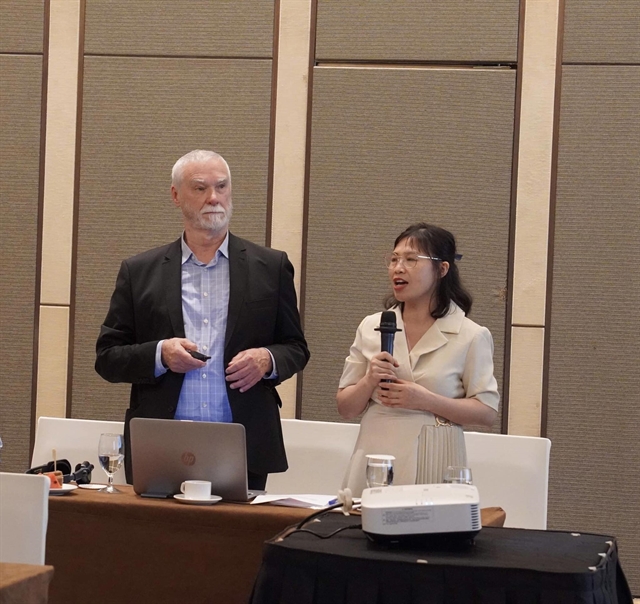 Opinion
Opinion


|
| Nguyễn Thị Ngọc Diệp (right) and Kim Sweeny together present the research in a conference in Hà Nội, Việt Nam. — Photo courtesy of the UNFPA |
PhD Nguyễn Thị Ngọc Diệp, postdoctoral research fellow from the Daffodil Centre, speaks to Việt Nam News reporter Thu Trang about the Investment Case Study on HPV Vaccination in Việt Nam.
What inspired you to conduct the research HPV vaccinations in Việt Nam? What were the targets?
The vaccine against human papillomavirus (HPV) has had huge success on a global stage. After hundreds of millions of doses have been delivered in more than 100 countries over the last 15 years globally, we know it is safe and highly effective at preventing HPV infections and cervical cancer, as well as other HPV-related cancers.
In 2020, the World Health Organisation launched a global strategy for cervical cancer elimination, which was structured around reaching three goals by 2030 – 90 per cent of young girls globally with be vaccinated against HPV, 70 per cent of women will be screened with a high precision test such as HPV testing a minimum twice in a lifetime, and 90 per cent of women that require access to cervical precancer and cancer treatment will be able to access such treatment.
Although there is clear evidence about the success of the HPV vaccine at the global level, Việt Nam's Ministry of Health (MoH) realised that there is a need to have scientific evidence on the cost-effectiveness and the return-on-investment of HPV vaccination and cervical cancer screening among the Vietnamese population to support the decision-making process regarding cervical cancer elimination in the country.
To respond to the MoH’s request, United Nations Population Fund (UNFPA) Việt Nam has connected with two research groups from Australia to conduct this evaluation.
The evaluation was led by me at the Daffodil Centre, a joint venture between the Cancer Council NSW and the University of Sydney, Australia [https://daffodilcentre.org/] and Dr Kim Sweeny, principal research fellow from the Victoria Institute of Strategic Economic Studies, Victoria University, Australia [https://www.vu.edu.au/]. It was conducted in consultation with UNFPA, the National Institute of Hygiene and Epidemiology (NIHE) and the country’s experts.
I was excited at the results of the study. I have been working to support HPV vaccine implementation in Việt Nam since 2009. After pursuing a PhD in this area, I am positive about the results of this study. Cervical cancer is a protectable cancer and now we have tools to prevent it. Therefore, no women in Việt Nam or globally, should die from this disease.
Dr Kim Sweeny also said that the results of this study provided strong support for the National Action Plan on Prevention and Control of Cervical Cancer in Việt Nam.
Can you give some key findings of the research?
Findings from our most recent study include:
HPV vaccination would be highly effective at a population level in Việt Nam, especially if 90 per cent coverage can be reached in girls. This could prevent more than 100,000 deaths by the end of the century and can help Việt Nam eliminate cervical cancer by 2084.
If we also offer primary HPV screening and adequate treatment for women with precancer and invasive cancer, we can eliminate cervical cancer by 2055 (29 years earlier than if vaccination was implemented alone), and this would prevent up to 300,000 deaths over the century.
Offering HPV vaccination for boys provides incremental benefits only and at this stage would not be cost-effective in Việt Nam.
For every dollar invested for cervical cancer prevention, Việt Nam will have US$5 to $11 returned in economic benefits and $8 to $20 returned as combined economic and social benefits (through 2100).
What are the advantages and disadvantages you faced during the research?
The advantage is that the model we used for the evaluation, Policy1-Cervix, is a longstanding, comprehensive and well-validated model that has been adapted to represent the Vietnamese population given the local data available.
But we also have disadvantages. First, as the study conducted during the COVID-19 pandemic, most activities have been conducted virtually. Secondly, data in the country is limited, particularly in rural areas of Việt Nam, which makes the modelling of long-term outcomes more challenging. At last, with huge efforts from the research team and great support from local experts, the study has been successfully completed on time and with high quality.
What are the research’s recommendations?
Our finding indicates that a national HPV vaccination programme for adolescent females would be highly effective and cost-effective in Việt Nam. Together with HPV vaccination, offering primary HPV screening for women aged over 30 and adequate treatment for those with precancer and invasive cancer could eliminate cervical cancer as a public health problem if this triple-intervention is offered across the country.
We hope these findings mean that these preventative measures, as well as better access to cervical precancer and cancer treatment, are made available to Vietnamese girls and women across the country. — VNS